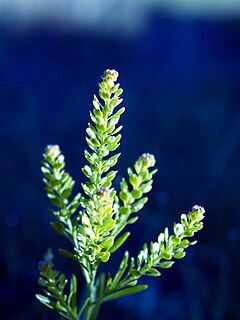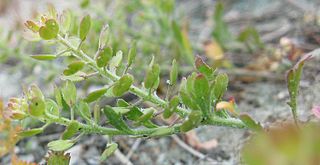
Lepidium latifolium, known by several common names including perennial pepperweed, broadleaved pepperweed, pepperwort, or peppergrass, dittander, dittany, and tall whitetop, is a perennial plant that is a member of the mustard and cabbage family.

Lepidium is a genus of plants in the mustard/cabbage family, Brassicaceae. The genus is widely distributed in the Americas, Africa, Asia, Europe, and Australia. It includes familiar species such as garden cress, maca, and dittander. General common names include peppercress, peppergrass, pepperweed, and pepperwort. Some species form tumbleweeds. The genus name Lepidium is a Greek word meaning 'small scale', which is thought to be derived from a folk medicine usage of the plant to treat leprosy, which cause small scales on the skin. Another meaning is related to the small scale-like fruit.

Lepidium virginicum, also known as least pepperwort or Virginia pepperweed, is an herbaceous plant in the mustard family (Brassicaceae). It is native to much of North America, including most of the United States and Mexico and southern regions of Canada, as well as most of Central America. It can be found elsewhere as an introduced species.

Phacelia crenulata is a species of flowering plant in the borage family, Boraginaceae. Its common names include notch-leaf scorpion-weed, notch-leaved phacelia, cleftleaf wildheliotrope, and heliotrope phacelia. It is native to the southwestern United States as far east as Colorado and New Mexico, and Baja California and Sonora in Mexico.
Lasthenia microglossa is a species of flowering plant in the daisy family known by the common name smallray goldfields. It is endemic to California, where it grows in shady areas in a number of habitats.

Lepidium densiflorum is a species of flowering plant in the mustard family known by the common names common pepperweed and prairie peppergrass.

Lepidium flavum is a species of flowering plant in the mustard family known by the common name yellow pepperweed. It is native to California, Nevada, and Baja California, where it grows in the Sonoran and Mojave Deserts. The species epithet flavum is Latin for yellow and indicates its flower colour.

Lepidium fremontii, the desert pepperweed, is a species of flowering plant in the mustard family which is native to the southwestern United States, where it grows on sandy desert flats and the rocky slopes of nearby hills and mountains. It takes its scientific name from John C. Frémont.
Lepidium jaredii is a species of flowering plant in the mustard family known by the common name Jared's pepperweed. It is endemic to California, where it is known from the San Joaquin Valley to just within the central Coast Ranges.

Lepidium latipes is a species of flowering plant in the mustard family known by the common name San Diego pepperweed. It is native to California and Baja California, where it grows in alkaline soils in a number of habitat types.

Lepidium montanum is a species of flowering plant in the mustard family known by the common names mountain pepperweed, mountain peppergrass, mountain pepperwort, and mountain pepperplant. It is native to western North America from Oregon to Montana to northern Mexico, where it can be found in a number of habitats, often on salty or gravelly soils. There are several varieties, many of which are difficult to distinguish.

Lepidium nitidum, known by the common name shining pepperweed, is a species of flowering plant in the mustard family.

Lepidium perfoliatum is a species of flowering plant in the mustard family known by the common names clasping pepperweed and perfoliate pepperwort. It is native to Europe and Asia and it can be found in other parts of the world as an introduced species.

Lepidium dictyotum is a species of flowering plant in the mustard family known by the common names alkali pepperweed and alkali pepperwort.

Lepidium oblongum is a widespread North American species of flowering plant in the mustard family known by the common name veiny pepperweed. It is native to Mexico, Guatemala, El Salvador, and the western and south-central United States. It is present as an introduced species in Hawaii. It can grow in many types of habitat.
Lepidium pinnatifidum is a species of flowering plant in the mustard family known in English by the common name featherleaf pepperweed.

Toxicoscordion paniculatum is a species of flowering plant known by the common names foothill deathcamas and sand-corn. It is widely distributed across much of the western United States, especially in the mountains and deserts of the Great Basin region west of the Rocky Mountains. It grows in many types of habitat, including sagebrush plateau, grasslands, forests, and woodlands, etc.

Lepidium barnebyanum is a rare species of flowering plant in the family Brassicaceae known by the common names Barneby's pepperweed, Barneby's pepper-grass, and Barneby's ridge-cress. It is endemic to Utah, where there is a single population in Duchesne County. It is a federally listed endangered species of the United States.

Lepidium papilliferum is a rare species of flowering plant in the mustard family known by the common names Idaho pepperweed and slickspot peppergrass. It is endemic to Idaho in the United States, where it is mostly limited to a specific habitat type in the southwestern part of the state. It was federally listed as a threatened species in 2009.

Lepidium heterophyllum,, is a species of flowering plant in the mustard family which is native to parts of western Europe, growing in shingle banks, wasteland or cultivated fields.
















